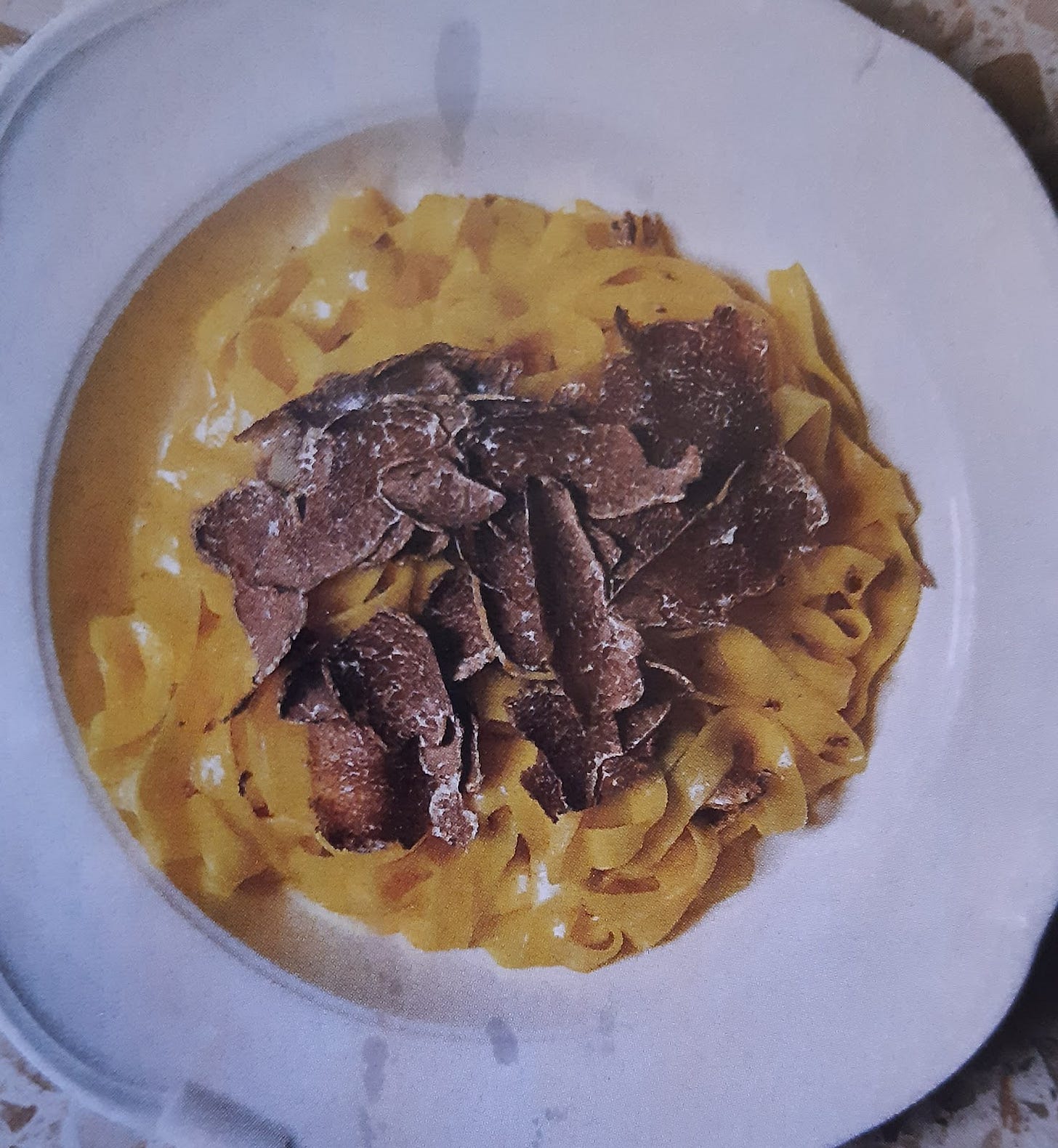Truffle hunters ruffled
A recipe for Truffle Pasta
Find more newsletters with recipes here. And my piece on the future effect of the crashing British hospitality business in The Globalist.
Once upon a Big Birthday, I was a deliriously happy guest at the most memorable lunch I’ve ever been to. It was a surprise celebration for a man with the gift of living life to its fullest. His equally inspiring and imaginative wife had taken a table at one of Washington DC’s most fashionable restaurants. She explained she had picked the guest list with a determination to invite individuals whose one thing in common would most amuse him. With the result that her discerning husband was the only man present.
Massively flattered to have been chosen, we delighted women were fed a luxurious feast - bowls of freshly made tagliatelle heaped with mountains of white Italian truffle shaved over them as we watched.
Until that meal, I hadn’t really got the point of truffles. It seemed to me they were not unlike eating pencil shavings imbued with the scent of unwashed underwear. The experience of holidays in south west France where I’d been exposed to the black Tuber melanosporum known in the Dordogne as the ‘black diamond’, didn’t seem to have rubbed off.
The white Italian truffles of that feast, Tuber magnatum pico, are the world’s rarest and the most expensive of the more than 100 varieties of the tuber. They sell for between $1800 and $4000 for 500g/1lb. But with global demand outstripping a supply now reduced to only a few tens of tonnes, they can go at auction for as much as $60,000 per kilo.
In 2017, a set of white Alba truffles weighing just shy of 1kg/2.2lbs sold for more than $85,000. That’s only $4000 less than the basic price of a 2018 Mercedes Benz S-Class sedan.
But that birthday feast was a meal that has been becoming almost too expensive to offer. Truffles are dying out.
Gnarled fungi believed by Plutarch to result from a combination of lightning, warmth and water in the soil, they are as old in origin as they look. Acknowledgement of their existence goes back as far as 20BC, when they were mentioned in neo-Sumerian inscriptions critiquing the eating habits of their enemy, the Amorites.
In the Dordogne only a century ago, hundreds of tonnes of black truffles were collected each season. These days, the region only manages fewer than ten tonnes, which explains their exorbitant price, despite being a lesser variety than white Italian truffles.
Part of the reason for their savage reduction in number is the changing climate. French truffle growers depend on storms and humidity during August to develop the truffles. But the month has become a series of long dry weeks. As a result, a kilo/2.2lbs of fusty-smelling subterranean lumps will fetch, at the cheaper end, around $4,000.
When the mature truffles come up for sale at the Dordogne’s January markets, good tubers weighing roughly 100g/3.5 ounces apiece can cost as much as $10,000 a kilo.
This is why your Petit Soufflé aux Truffes Noires, or whatever other exotic tuber-scented dish is on offer at your local Michelin-starred restaurant, is so very expensive.
Truffle production in Italy has also been in radical decline, forced by an alteration in land use and the resulting loss of wild habitat along with the oak, hornbeam, poplar and willow trees among whose roots the tubers nestle, waiting for trained dogs and pigs to snout them out.
But now comes news which should delight Birthday Richard.
France's National Research Institute for Agriculture, Food and Environment (INRAE) has spent the past nine years with a truffle grower, Robin Pépinières, trying to cultivate white truffles in orchards across France in regions with differing climates. Last week it reported successful results.
The scheme goes back to the 1970s, when French truffle growers developed techniques that delivered nutrients to encourage fungi to produce vegetative filaments which become truffles. These techniques now account for 90% of French black truffle cultivation.
Applying these to Italian white truffle cultivation, they have just managed for the very first time to harvest white truffles in the Rhône-Alpes, Bourgogne Franche Comté, and Nouvelle Aquitaine.
Black diamonds better watch out. And the rest of us may soon be able to eat White Truffle pasta affordably, and Richard won’t have to wait for a birthday.
Until then, if you can afford to, buy a cheaper small black truffle from the Dordogne. A small amount of them will go a long way, across several celebratory, transforming, meals. Shave them over an omelette of the best eggs you can buy. Or make Richard’s Birthday Feast.
Serves 4
150g/4 ¼ oz butter
100ml/3.5 fluid ounces stock
400g/14 ounces fresh tagliatelle
Salt and freshly ground black pepper
30g/1 ½ ounces truffle, shaved
In a pan over low heat, melt the butter in the stock then whisk to amalgamate into a sauce. Set aside.
Bring a pan of salted water to a boil, add the taglietelle and cook for 3-4 minutes till al dente - more chewy than you think right. Drain and toss with the butter and stock and season to taste.
Divide into warmed bowls and shave the truffle over each.





Worth trying are the Kalahari truffles, seasonal, climate change affected, but a lot cheaper!
What a discerning friend!